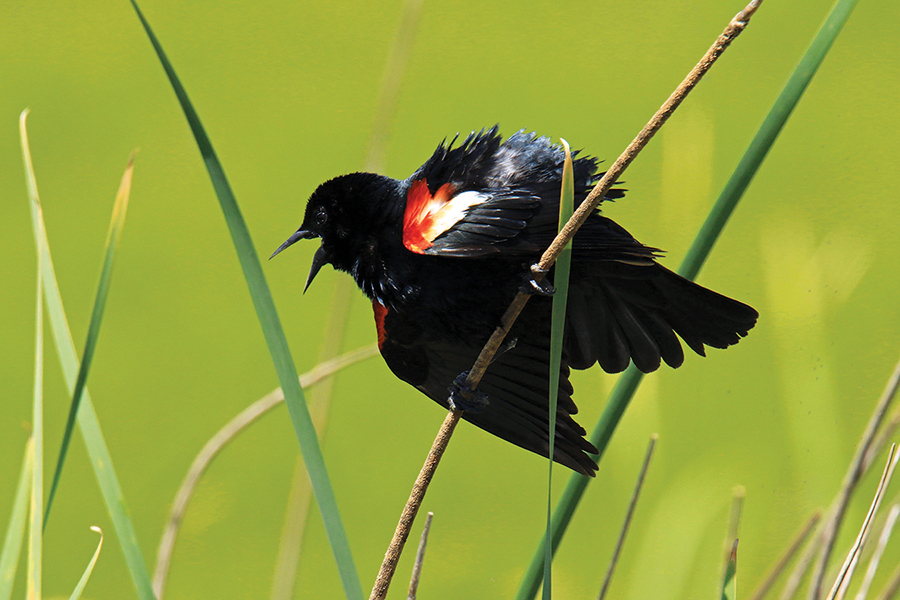
Tricolored blackbirds can be identified by the white stripe at the base of the male’s otherwise red epaulet. Photo by Tom Muehleisen.
By Aleta George
A study published in the journal Science in 2019 found that bird populations in North America have taken a nosedive in the last 50 years. By crunching data from citizen scientist counts and surveys, scientists found that there are three billion fewer birds than there were in 1970.
One species that has taken a heavy hit is the tricolored blackbird, whose population has plummeted from several million in the mid-19th century to less than 180,000 today, according to Audubon California. In response to the population crash, a band of individuals and conservation organizations are finding creative ways to bring this bird back from the brink. Their efforts to protect this one species serve as an example of the collaboration and ingenuity needed to address the overall loss of bird populations in the Western Hemisphere, especially with the advent of climate change.
Sometimes one person’s actions can make a difference. After several years of recording the songs and calls of breeding tricolored blackbirds in Solano County, volunteer Wendy Schackwitz is driving the length of California in her RV to place AudioMoth sound recorders in breeding colonies of tricolored blackbirds, named for the jaunty white stripe at the base of the male’s scarlet epaulet. Trikes, as they are fondly called, are closely related to the more common red-winged blackbird, but unlike red-winged blackbirds, they are almost strictly a California bird. Also unlike the red-winged variety, trikes are colonial nesters, the largest in North America. “It’s their one claim to fame,” said Schackwitz.
Schackwitz’s interest in tricoloreds began in 2016 when Solano Land Trust asked her to monitor a breeding colony near a restored pond at Rush Ranch, a 2,070-acre open space preserve in Suisun City. Schackwitz, a retired geneticist who was then the president of Napa-Solano Audubon, observed two rounds of nesting that year. But even with weekly visits, she wanted to know more about the birds.
The following year she applied for a small grant to pursue an idea inspired by Soundscapes to Landscapes, a project that studies bird diversity across landscapes through bioacoustics and modeling. She wondered what she could learn about the breeding colony at Rush Ranch if she dedicated her bioacoustics monitoring to that one species. Could a map of their sounds inform her about the breeding timing of the birds?

Wendy Schackwitz recorded the songs of tricolored blackbirds at Rush Ranch. Photo by Aleta George.
She recorded the birds at Rush Ranch during the 2017 breeding season. With lots of rain, a full pond, and juicy bugs for the birds to eat, it was a good year for the trikes. At the height of the season, she counted 2,000 birds (high for Bay Area colonies, but not for San Joaquin Valley colonies that can number in the tens of thousands). With thousands of hours of recordings, she created a sonogram, a picture of sound in graph form. By matching the sounds to observations made on site visits, she was able to link specific sounds to behaviors. She chose three vocalizations on which to focus: the male song, which meant courting; the female song, which meant nesting; and the end of the female song, which meant hatching of the chicks. With this information, she was able to determine the exact number of nesting attempts, and the dates the babies hatched, information that in the future could be of potential use to farmers and conservation groups in the San Joaquin Valley.
California’s Central Valley was once a giant wetland where tricolored blackbirds and other birds and wildlife found suitable habitat for breeding and feeding, and as the wetlands were being swallowed by cities and farms, the trikes adjusted. They found alternative nesting habitat in introduced Himalayan blackberry thickets and grainfields of triticale, grown as feed by dairy farmers. The problem with their adaptation is that the time to harvest the triticale is synchronous to the breeding cycle of tricolored blackbirds.
The blackbirds were being slaughtered during harvest, and with the majority of the population breeding in Central Valley grainfields, something had to be done. Audubon California biologists knocked on farmers’ doors to inform them of the problem, but it wasn’t enough. “The farmers want to respect the birds, but they are also trying to make a living,” said project manager Xerónimo Castañeda. “[We] needed a more concerted and organized effort to educate the producers on why they needed to protect the birds, and we needed resources to help.”
In collaboration with Western United Dairies, Dairy Cares, the California Farm Bureau Federation, the California Department of Fish & Wildlife, and the U.S. Department of Fish & Wildlife, Audubon California applied for and received a grant from the USDA Natural Resources Conservation Service. With that funding in place since 2014, they have educated dairy farmers about the problem, and compensated them for delaying their harvests until the baby birds fledge and the colonies leave the area.
“It has become a real-time, rapid response action,” said Castañeda. Once a colony lands to breed, Castañeda contacts the ag partners, who call the dairy farmers. “It’s been a huge success, and in 2020 we protected pretty much 100 percent of the colonies that we found on dairy fields.” The largest colony last year had about 25,000 birds.
“Whether it’s drinking a glass of milk or eating some nice cheese, that milk could have come from one of the dairies that is participating in our program,” adds Castañeda, who said the program costs, at minimum, $500,000 a year.
After her first year of recording, Schackwitz expanded her efforts and for two years placed recorders at several other sites in Solano County, which still supports several small breeding colonies in natural habitats. This year she invested $5,000 of her own money on new equipment, and with data obtained from eBird — an online bird-sightings database — is tracking colonies up and down California. She had hoped to place 40 to 50 recorders, but the logistics have proven challenging. Many of the breeding sites are on private property, and gaining permission is often a process that takes time.
With an introduction from Castañeda, Schackwitz will place a recorder on at least one San Joaquin Valley dairy farm this year. “I’m excited to learn more about the timing of [the birds’] nesting and when they are on the landscape,” said Castañeda, who conducts site visits of breeding colonies once or twice a week. The recordings will provide near continuous data. “Hopefully, the data will provide more precision in when the birds will be out of the fields so that the farmers can return to their work.”
Another potential site in the Bay Area where Schackwitz may place a recorder is in Santa Clara County, but she won’t know until April when a site visit confirms that the birds have returned to the same site. In Santa Clara County, there are three to four small breeding colonies of tricolored blackbirds, though the number of birds and number of sites were once much larger. “They liked those wetland valley floors with cattails, which Santa Clara Valley used to have,” said wildlife biologist Ryan Phillips, who in 2014 conducted the first survey of trikes in that county.
All but one of the extant breeding colonies are on private land, and not protected. The one public site that has had a breeding colony in the past is in Cañada de los Osos Ecological Reserve, owned and managed by the California Department of Fish & Wildlife. The Santa Clara Valley Habitat Agency is planning to improve the habitat of a 14-acre pond to entice trikes. Improving habitat for the blackbirds will also make it more habitable for red-legged frogs and western pond turtles. The cost of the project is unknown as it’s still in the planning stage.
Phillips and others are thinking even bigger. “In my opinion, Coyote Valley could be the stronghold in the region for tricolored blackbirds,” he said, citing the restoration potential of natural protected lands. Restoring habitat is not a guarantee that blackbirds will come, however. In addition to suitable breeding habitat, the birds need to forage for their young in the vicinity of their colonies, which adds another layer of complications. The decline in insect populations from insecticides and herbicides is a significant factor in the birds’ survival. Climate change is another issue. According to a 2019 report by Audubon, Survival by Degrees, at least one-third of the tricolored range will be lost as the climate shifts.
The tricolored blackbird is one bird among many that has had to adapt to our world, and efforts to save it illustrate the complexities and costs required to protect a species from going extinct. Castañeda gleans hope from the Audubon California program. “We like to share this story as a kind of champion because it has brought together all these different stakeholders to move towards the common goal of protecting this iconic species that can’t be found anywhere else in the world.”
Aleta George covers open space for the Monitor.

